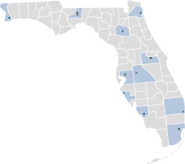Bright Futures Scholarship Program
 | |
| Formation | 1997 |
|---|---|
| Type | Merit based Scholarship |
Budget | $436 million |
| Website | Official website |
Bright Futures is the name of a scholarship program in the state of Florida. It is funded by the Florida Lottery and was first started in 1997.
Controversy and Reform Proposals
The Bright Futures Scholarship was first created in 1997, and was meant to emulate neighboring state Georgia's HOPE Scholarship. Originally the Program disbursed just above 42,000 scholarships for about $70 million. Over the last decade the cost for the scholarship has ballooned substantially. The Scholarship is solely funded by lottery proceeds, and was appropriated 329.4 million through the Educational Enhancement Trust Fund for 2012-13. It was appropriated even less in FY 2013-14 for $303.8m.[1][2][3] Families that before could count on tuition, fees and books being covered are now paying for books and fees and over half of tuition [4] A University of South Florida analysis predicted that the new Bright Futures standards would benefit far fewer students — the total number of college freshmen getting scholarships at state universities would drop by about half, from 30,954 to 15,711. The analysis predicted Hispanic students would see a 60 percent drop in scholarships, and black scholarship recipients would plummet by more than 75 percent.[5]
Before the Great Recession, Bright Futures received 26% of Lottery Funds in 2006-07. In the 2013-14 budget, it will receive 18% of the Lottery Funds. Much of the Lottery Fund is now being used to pay debt service for bonds on Lottery Funds.
While many types of controversy have existed over the course of the program's existence, the Legislature's excuse is that Bright Futures is solely merit-based in its award determination. This allows students whose parents could afford the tuition and fees to receive the funding over needier students. They state there are myriad programs designed to assist the poor and first-generation-in-college student on federal, state, and institutional levels.[6] The cost of college is now largely in living while in school as food, rent, and books cost far more than tuition and mandatory fees.[7] As a result, the scholarship may not be as impactful as it would be in a higher-tuition state.
See also
Notes
^ 1. The GPA used to calculate for Bright Futures eligibility is not the same as what a high school student might have for his or her current GPA. The GPA is calculated by just using the "core classes" which are the classes that are required for graduation.
^ 2. Just like the Gold Seal Vocational Scholars Award, the high school GPA is calculated by "core classes"
^ 3. Criteria for GPA is the same as the criteria for the Florida Medallion Scholars Award.
References
- ↑ Naplesnews.com article about costs
- ↑ Sun-Sentinel article about problems
- ↑ Expensive Program
- ↑ http://www.saintpetersblog.com/archives/153961
- ↑ http://www.tampabay.com/news/education/college/feds-investigate-floridas-bright-futures-scholarship-program/2171469
- ↑ Kaczor, Bill. "Cuts Likely for Bright Futures Scholarships". Miami Herald. Retrieved 2011-09-28.
- ↑ FSU office of FInancial Aid. "Cost of Attendance: Fall 2011/Spring 2012". Florida State University. Retrieved 2011-09-28.
External links
- Bright Futures website
- Bright Futures causes budget woes
- History of the scholarship
- Medallion Scholarship
